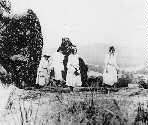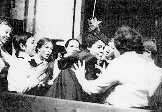
Australian Films, 1900-1977
Entry on Picnic at Hanging Rock
 The Girls on the Rock |
Picnic at Hanging Rock is a tale of mystery and menace in a sunny Australian landscape. Its story of late-Victorian schoolgirls and a teacher who vanish while exploring the volcanic outcrop of Hanging Rock offers many tantalizing possibilities; the suggestion of a time warp (sounds of the search for the girls are heard before they are lost), the dreamlike haze of a hot summer's day in the bush that makes things seem not quite what they are, and the awe-inspiring power of the Australian bush, which alienates some and hypnotically absorbs others.
The mysteries of Joan Lindsay's book were scrupulously cultivated by the film-makers. Weir created a thorough network of visual, verbal and aural imagery which deepened the mystery; flower symbolism, scars that appear on the foreheads of sympathetic characters, the singing of 'Rock of Ages', haunting pan-pipe music, and much more, supported its animistic force. Enigma also surrounded the source of the story; the public was encouraged by both the novelist and the film-makers to believe that the disappearance had actually happened.
The book was first published in 1967 and the screen rights secured by Patricia Lovell in 1973. After two years in search of funds, the production began in February, 1975 with backing from the Australian Film Development Corporation, B.E.F. Distributors, and the South Australian Film Corporation, whose investment was conditional upon the film being shot substantially in South Australia. The total budget was around $450,000. The six-week shooting schedule began with scenes at Hanging Rock in Victoria followed by work in South Australia, at the historic mansion of Martindale Hall near Mintaro (for exteriors of the school building), and in the S.A.F.C.'s studio in Adelaide. The British actress Vivien Merchant was cast as the unstable headmistress of the girls' school, but fell ill shortly before her arrival in Australia and her place was taken by the Welsh actress, Rachel Roberts. Distributed by B.E.F., the film had its world premiere at the new Hindley cinema complex in Adelaide on 8 August 1975. It became an immediate commercial and critical landmark in Australian cinema. Its popularity in Australia was followed by international critical acclaim at Cannes in May 1976, and it readily found sales in England and Europe, and later in the U.S.A.
On the strength of its success, Patricia Lovell quickly became one of Australia's busiest producers. She had had long experience in television, working as a compere of a children's programme, Mr. Squiggle, for the Australian Broadcasting Commission, as a reporter on the current affairs programme, Today, for the Seven network, and as an actress in series such as Skippy and Homicide.
Cliff Green, too, found his career greatly boosted by the film. It was his first screenplay for a feature film, but he had previously written prolifically for television and radio, including serials, children's programmes and documentaries for the ABC, and for three years had been a staff writer for Crawford Productions in Melbourne preparing episodes of Homicide and Matlock Police. He later worked as a freelance writer and contributed episodes to many ABC series, including Rush and The Norman Lindsay Festival. A quarter of plays by Green, under the group title of Marion, was televised by the ABC in 1974 and attracted much attention for their perceptive portrayal of a young schoolteacher (played by Helen Morse) in a small country town.

Another scene from the movie |
Back to start of Hanging Rock section
My Index Page
|